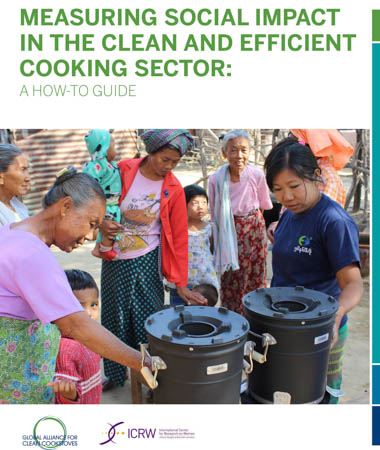Measuring Social Impact in the Clean Cooking Sector
Good organizations are inquisitive. They ask questions like, “How are my customers using my products?” and “How can I improve my products and services to better meet my customers’ needs?”
But great organizations go further. They ask, “How are my products and services making a difference in people’s lives beyond their everyday use?” This is where “social impact” begins.
In the cookstoves sector measuring these benefits—or social impact–is incredibly important. For example, knowing how a new stove impacts the social and economic well-being of customers can improve marketing, increase sales, and even help in developing new products. But without a well-calibrated tool, measuring these impacts has been incredibly difficult.
To address this, the Alliance partnered with the International Center for Research on Women (ICRW) to develop a comprehensive toolkit that allows cookstoves and fuels enterprises to measure how their products empower women and create social change. Developed over two years of thorough research, testing, and evaluation, the “Measuring Social Impact in the Clean and Efficient Cooking Sector: A How-To Guide” uses common language and agreed upon indicators to guide organizations seeking to better understand the benefits they deliver to consumers.
The process behind the structured framework brought together stakeholders from across the sector to agree upon those indicators that matter most for social impact through a proven, multi-year process and methodology rigorously vetted by ICRW. The Social Impact Measurement System, which has a particular emphasis on how these programs impact women, helps partners examine a range of benefits, from income and the quality of jobs created to decision-making power and time use.
“The social impact measurement system captures the potential gains of adoption of clean and efficient cookstoves to individuals and households,” Sarah Gammage, ICRW's Director of Gender, Economic Empowerment and Livelihoods, noted. “[It] demonstrates the importance of investing in modern, sustainable energy solutions and last-mile connectivity for poor, rural populations and in particular for women and girls.”
For the first time, there is common language for the measurement, analysis, and reporting of social impacts related to clean and efficient cookstoves and fuels. This standard language will allow users to effectively quantify and verify impact to investors, donors, or other partners.
For Emmy Wasirwa, founder and CEO of Wana Energy Solutions in Uganda, the ability of the tool to provide the metrics to understand consumer feedback was priceless:
“The Social Impact Measurement Tool helped us improve the services we offer to our community. For example, we learned that the product [stove] we were offering was too expensive for many with small disposable income, so we offered pay as you go service”
His one piece of advice to others considering to use the tool? Go back and listen to the community:
“Go out, speak to customers, understand them, and then you can design something better than what you are offering to them.”
With increasing public and private investment in the clean cooking sector, understanding the social impact of clean and more efficient technology has become more important than ever. To build the veracity of an organization and the services it provides requires understanding the magnitude of social impact being achieved worldwide, enabling organizations to tell powerful stories about how clean cookstoves and fuels are creating social change across contexts and settings. The Social Impact Measurement System will help you to begin telling that story.

